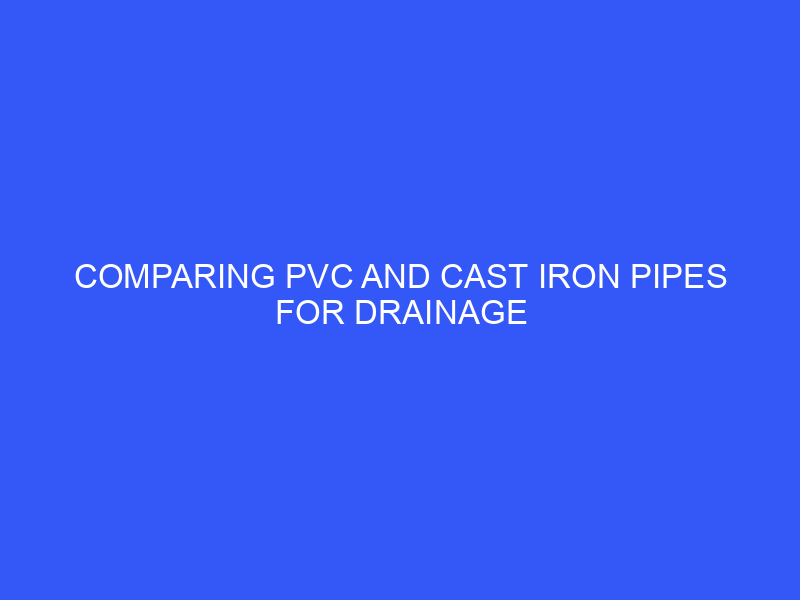There are different sorts of pipe materials accessible available; however, two are generally used. Cast iron and plastic pipes are used in all customary homes, while cast iron and plastic lines are used in practically all cutting-edge abodes. Consider all highlights of plastic pipe versus cast iron line while picking material for the pipes.
Since there are significant qualifications between the two kinds of pipes, getting a handle on all elements connected with each pipe is essential. While choosing a channelling material, consider the sort of water it will convey, the general expense contrasted with its helpful life, and the idea of the dirt wherein the funnelling will be laid.
The material should be erosion-safe all around, or it should be satisfactorily safeguarded against corrosion. Each pipe enjoys benefits and drawbacks; their administration is not entirely set in stone by the establishment climate, the sort of water going through them, and how well they are introduced.
Accordingly, this blog looks at cast iron versus PVC pipe. This correlation will help you in choosing the best pipe for your home.
Plastic Pipes vs Cast Iron Lines
The following points will assist you in distinguishing between plastic pipes and cast iron pipes:
General
Plastic Pipe
Plastic pipes are becoming more popular because of their corrosion resistance, lightweight, and cost-effective features, according to Subhash M. Patil (author of Plumbing Engineering). Plastic pipes have advantages and disadvantages.
Cast Iron
It is perceived by its dull colour, unforgiving surface, and colossal surface district. Cast iron is a metal composite of iron, carbon, and silicone. Since it isn’t flexible, it is projected (consequently the name) in a mould to deliver things like pipes.
Size
Plastic Pipe
The pipes are accessible in sizes going from 17 to 609 mm. Nonetheless, the most widely recognized sizes (outside measurement) are 21.2 mm, 26.6 mm, 33.4 mm, 42.1 mm, and 60.2 mm.
Cast Iron
Cast iron pipes are available in nominal internal diameters of 50,65,75,90,100,125, and 150 mm.
Durability
Plastic Pipe
When compared to cast iron pipes, plastic pipes are less durable. Polymer-based pipe systems have a service life of 50-80 years.
Cast Iron
When compared to plastic pipes, cast iron pipes have a longer lifespan. Cast iron drainage pipes in homes dating back 80-100 years are still intact and working.
Adjustability
Plastic Pipe
Plastic pipes cannot be altered after they have been installed. As a result, any alterations necessitate the replacement of a whole section of pipes. This presents a significant issue when changing the house.
Cast Iron
Cast iron pipes may be easily adjusted. Even after installation, they can be re-oriented and altered. This is useful when remodeling the house because the essential pipes can be readily changed.
Fire Resistance
Plastic Pipe
Plastic pipes are less heatproof than cast iron pipes. In case of a home fire, it can promptly consume and start to melt, creating an opening through which blazes can move, starting with one piece of the structure and then onto the next.
Cast Iron
Cast iron pipes are extremely fire-resistant. They will not melt in the event of a house fire. Because cast iron pipe is fireproof, it stops the spread of fire considerably better than plastic pipe.
Environmental Concerns
Plastic Pipe
Those seeking an environmentally friendly construction should avoid using plastic pipes, which are not eco-friendly. Plastic manufacture emits hazardous gasses into the atmosphere.
Cast Iron
Cast iron is an environmentally beneficial material. They can be produced from scrap iron and recycled once their useful life has expired.
Cost
Plastic Pipe
Plastic pipes range in price from INR 100 to INR 1000 per piece, depending on thickness and quality.
Cast Iron
Cast iron pipe costs between INR 700 and INR 4000 per piece, depending on thickness and manufacturer. Plastic pipes are less expensive than cast iron pipes.
Expansion Joints
Plastic Pipe
Plastic pipes have a higher coefficient of expansion and contraction than cast iron pipes. As a result, for pipelines longer than 30 feet, an expansion joint must be installed.
Cast Iron
Because cast iron pipes have a low coefficient of expansion and contraction, expansion joints are not required in cast iron pipe systems.
Noise
Plastic Pipes
Plastic pipes are light in weight, and when water flows through them under high pressure, vibrations may occur, causing some noise.
Cast Iron
Since cast iron pipes are very weighty, there will be no vibration regardless of whether water flows through them at high pressure. Thus, there is no compelling reason to be worried about noise while utilizing cast iron pipes.
Water Friction
Plastic Pipe
The smooth surface of plastic pipes reduces fluid friction and creates a more uniform flow. As a result, there is less energy loss with plastic pipe, and the pipe performs better.
Cast Iron
When opposed to plastic pipes, cast iron pipes have a relatively rough surface.
Advantages
Advantages of Plastic Pipes
The essential benefit of plastic pipes is that they are:
- More affordable than other line materials.
- Cast iron pipes are heavier than plastic pipes.
- They are easily cuttable.
- Transportation and installation are straightforward due to its minimal weight and ease of usage.
- Plastic pipes necessitate fewer joints.
- Plastic pipes perform better because of their flat surface, which reduces energy loss.
Advantages of Cast Iron
- Cast iron pipes are more durable than plastic pipes.
- They are more durable than plastic pipes.
- They have a low expansion/contraction coefficient.
- Cast iron pipes resist fire and do not burn during house fires.
- It is a material that is good for the environment.
Disadvantages
Disadvantages of Plastic Pipes
- When using plastic pipes near water heaters and other heat sources, practice extreme caution.
- Most plastic pipes are not approved for drinking water usage, not because of a high danger of toxicity but because they can decay when exposed to UV light, high temperatures, and extremely high pressures.
- Plastic pipe manufacturing is not environmentally friendly.
- They have less durability than cast iron pipes.
Disadvantages of Cast Iron
- They are more costly.
- Cast Iron is a heavy metal that is challenging to cut and fit.
- They are accessible in various lengths.
- With age, the pipe’s interior gets rough, reducing carrying capacity.
- Corrosion can cause pipe damage.
FAQ’S
Is PVC or cast iron better for drains?
We prefer PVC for residential sewer lines because of its durability, low cost, and regular flow rates. Cast iron is a terrific alternative if you require a heavier-duty commercial line, must comply with tight fire-stopping rules, or want the quietest possible plumbing system.
Which pipe is best for the drainage line?
As a result of its strength, toughness, and erosion opposition, PVC pipes are the ideal decision for most drainage projects. They are additionally sensibly valued and easy to install. PVC pipes can bear the weight of soil and water and are not easily damaged by roots or debris.
Which drainage system is better?
Closed drainage is less expensive to construct than open drainage. Cleaning closed drainage is less difficult than cleaning open drainage. Closed drainage keeps humans safe from hazardous waste. Closed drainage requires no wastewater treatment.


